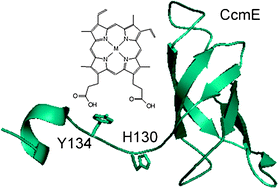Metal and redox selectivity of protoporphyrin binding to the heme chaperone CcmE†
Abstract
The interaction of

- This article is part of the themed collection: Cytochromes
a
Department of Biochemistry, University of Oxford, South Parks Road, Oxford, United Kingdom
E-mail:
stuart.ferguson@bioch.ox.ac.uk
Fax: +44 (0) 1865 275259
b Department of Chemistry, University of Cambridge, Lensfield Road, Cambridge, United Kingdom
The interaction of

 Please wait while we load your content...
Something went wrong. Try again?
Please wait while we load your content...
Something went wrong. Try again?
 Fetching data from CrossRef.
Fetching data from CrossRef.
This may take some time to load.
Loading related content
